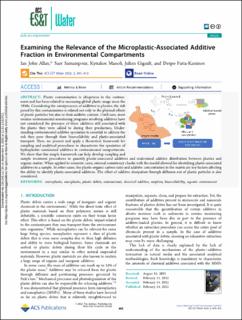| dc.contributor.author | Allan, Ian | |
| dc.contributor.author | Samanipour, Saer | |
| dc.contributor.author | Manoli, Kyriakos | |
| dc.contributor.author | Gigault, Julien | |
| dc.contributor.author | Fatta-Kassinos, Despo | |
| dc.date.accessioned | 2022-09-09T12:44:50Z | |
| dc.date.available | 2022-09-09T12:44:50Z | |
| dc.date.created | 2022-03-02T12:32:26Z | |
| dc.date.issued | 2022 | |
| dc.identifier.citation | ACS ES&T Water. 2022, 2 (3), 405-413. | en_US |
| dc.identifier.issn | 2690-0637 | |
| dc.identifier.uri | https://hdl.handle.net/11250/3016921 | |
| dc.description.abstract | Plastic contamination is ubiquitous in the environment and has been related to increasing global plastic usage since the 1950s. Considering the omnipresence of additives in plastics, the risk posed by this contamination is related not only to the physical effects of plastic particles but also to their additive content. Until now, most routine environmental monitoring programs involving additives have not considered the presence of these additives still associated with the plastic they were added to during their production. Understanding environmental additive speciation is essential to address the risk they pose through their bioavailability and plastic-associated transport. Here, we present and apply a theoretical framework for sampling and analytical procedures to characterize the speciation of hydrophobic nonionized additives in environmental compartments. We show that this simple framework can help develop sampling and sample treatment procedures to quantify plastic-associated additives and understand additive distribution between plastics and organic matter. When applied to concrete cases, internal consistency checks with the model allowed for identifying plastic-associated additives in a sample. In other cases, the plastic-organic carbon ratio and additive concentration in the matrix are key factors affecting the ability to identify plastic-associated additives. The effect of additive dissipation through diffusion out of plastic particles is also considered. | en_US |
| dc.language.iso | eng | en_US |
| dc.publisher | American Chemical Society | en_US |
| dc.rights | Navngivelse 4.0 Internasjonal | |
| dc.rights.uri | http://creativecommons.org/licenses/by/4.0/deed.no | |
| dc.title | Examining the Relevance of the Microplastic-Associated Additive Fraction in Environmental Compartments | en_US |
| dc.type | Peer reviewed | en_US |
| dc.type | Journal article | en_US |
| dc.description.version | publishedVersion | en_US |
| dc.rights.holder | © 2022 The Authors. | en_US |
| dc.source.pagenumber | 405-413 | en_US |
| dc.source.volume | 2 | en_US |
| dc.source.journal | ACS ES&T Water | en_US |
| dc.source.issue | 3 | en_US |
| dc.identifier.doi | 10.1021/acsestwater.1c00310 | |
| dc.identifier.cristin | 2006959 | |
| dc.relation.project | Norges forskningsråd: 297334 | en_US |
| cristin.ispublished | true | |
| cristin.fulltext | original | |
| cristin.qualitycode | 1 | |

